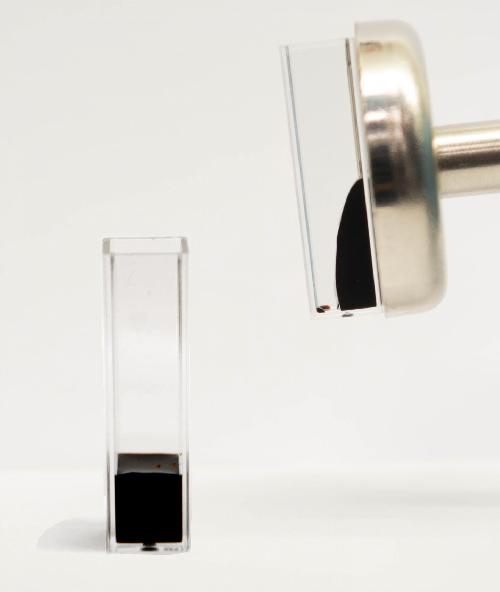Researchers from ITMO University, the Hebrew University of Jerusalem and Cyril and Methodius University in Skopje have fabricated a new magnetically controlled material composed of enzymes entrapped directly within magnetite particles. Combined with water, it forms a stable solution that can be used for safe intravenous injection for medical purposes, in particular, for targeted treatment of cancer and thrombosis. Previously, the synthesis of similar materials involved using additional components that impaired the magnetic response and enzymatic activity as well as created obstacles for intravenous injection into the human body. The results of the study were published in the Chemistry of Materials magazine.
The researchers are going to apply this approach to the treatment of thrombosis. Targeted magnetic introduction of enzymes that dissolve the clot seems to be a very promising approach in terms of fighting the disease. "Using a magnetic field, the particles can be condensed on blood clots; moreover, such systems will work for quite a long time until the enzyme is completely oxidized", says Andrey Drozdov, research associate at the International laboratory of Solution Chemistry of Advanced Materials and Technologies (SCAMT).
What makes the difference with the new material is that particles of magnetite with entrapped enzymes are extremely resistant to sedimentation in water. This was made possible thanks to a new method of magnetic hydrosols synthesis devised by ITMO University researchers.
 Self-stabilizing magnetic colloid. Credit: ITMO University
Self-stabilizing magnetic colloid. Credit: ITMO University
Thus, the resulting system stabilizes itself without any need for additional stabilizers that may attenuate its magnetic properties, reduce the enzymatic activity and increase potential toxic effect for humans. The nanocomposite is absolutely biocompatible and harmless for injection into the human body. "Separately, both magnetite and therapeutic enzymes have medical approval for intravenous Injection. Therefore, to approve their joint use should not be difficult. The body already knows what to do with these substances and how to incorporate them into the process of metabolism," adds Andrey Drozdov.
The approach allows scientists to create magnetically controlled solutions of practically any enzyme that has some industrial or therapeutic value. To demonstrate this versatility, the researchers encased five different enzymes in such a magnetite "armour".
Enzymes are added directly in magnetite hydrosol. Magnetite particles surround the enzymes and after drying out form a firm porous structure, whereof the enzyme cannot escape anymore. "This method was tailored to be used with enzymes," explains Vladimir Vinogradov, head of International laboratory of Solution Chemistry of Advanced Materials and Technologies, "We have selected the material so that after packing, it could physically hold the enzyme inside. At the same time the enzyme is able to carry out its function through the pores in the material."
In addition, the researchers discovered that entrapped enzymes were characterized by increased thermal stability. According to the experiments, protected enzymes remained functional at temperatures exceeding the temperature of their thermal decomposition in free form by more than 20 degrees Celsius. This phenomenon can facilitate the extension of the application range of enzymes in a variety of environments that are sensitive to temperature conditions.
The scientists suggest that magnetite particles protect the enzyme from denaturation (i.e. the process of losing its native structure because of increasing temperature or changing pH) physically by applying pressure on the enzyme from the outside. Thus, the magnetite plays a role of a solid framework.
source: ITMO University